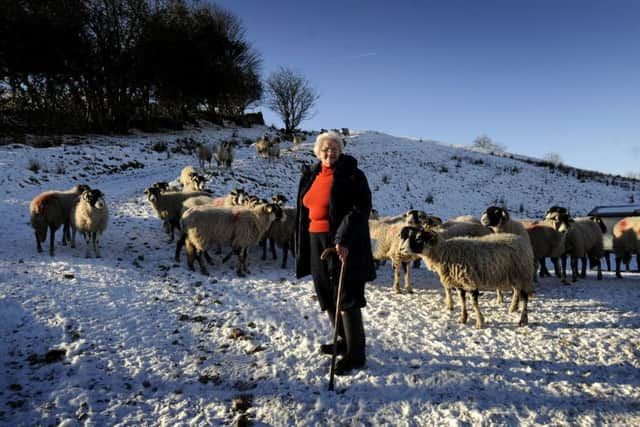Dales in crisis: Unbroken by winters... can they survive march of time?
A ‘hefted’ sheep, she says, knows how to ride out a storm. And the people here, she adds, are ‘hefted’ too. They have to be, to weather the harshest of winters amid the rocky crags and steep gills of this rugged landscape.
Oxnop Hall, the family farm, sits high on the hills above Gunnerside. In the Porters’ living room, in front of a roaring fire and surrounded by framed photographs of their many grandchildren, it is easy to forget the bitter winds outside. But for Dales folk, say the Porters, it is a way of life they are accustomed to. And as times are changing for the community around them, it is time for the Dales to change too.
Advertisement
Hide AdAdvertisement
Hide Ad“They are never finished, Dales families,” said Mrs Porter’s husband, John. “We’re hill men. A hill man will never break. He’s learned, living up these ways, how to do without.”


Mrs Porter’s family has farmed these hills for generations. Mr Porter, now 80, can trace his own farming roots here as far back as the 15th century. The couple have four children, and seven grandchildren. Only two of the seven remain in the National Park.
“The children grow up, they go away to school and they see a better life,” said Mrs Porter, 78. “We’ve got five grandchildren all away. They won’t come back. How can young people live here when there isn’t any work?”
The issue, says Mrs Porter, is not a lack of children. She’s counted – there are 44 in and above Gunnerside, with three more on the way. Two babies are due within the fortnight. There is a thriving grouse industry which is bringing in gamekeepers with young families, and there are more children in this part of the Dales than there has ever been, she claims. But when they get older, they leave to settle elsewhere.
Advertisement
Hide AdAdvertisement
Hide AdCecilia Harvey, the chairwoman of Kettlewell with Starbotton Parish Council, agrees.


“It’s always happened, it’s not a new problem,” she says. “When you live in the countryside, the bright lights of the city can be attractive to a young person. Around here, there aren’t any young people.
“The demographic of 18 to 35, it just doesn’t exist.
“We have a thriving community in Kettlewell and Starbotton; it’s very strong. But it’s an elderly community. We aren’t doing enough to make young people want to stay.”
Richmondshire councillor Ian Scott said there is a shift in the traditional way of life. Fifty years ago, 70 per cent of the Dales income came from farming. Now, he said, it’s about 10 per cent.
Advertisement
Hide AdAdvertisement
Hide Ad“It’s just different to how it was,” he said. “A lot of the smaller farms have gone. They can’t make a living. Tourism is what’s keeping the Dales going.”
Tourism – and in particular the subject of second-home ownership – is fuelling debate. There are a rising number of second homes, National Park chiefs have said, with the impact on communities being a shortage of houses while too many holiday lets are left empty for half the year.
Mrs Harvey, in Starbotton, says there are 54 houses in the village. Only 20 are lived in full-time. In Arkengarthdale, said to have the highest rate of second homes in the park, there are just 14 students in the village school. But with the park increasingly reliant on tourism for income and trade, there is an argument that taxing those who are spending will result in a loss all round.
Keith Sharpe, landlord at the community-run Foresters Arms pub in Coverdale, said 35 per cent of houses in the village are second homes or holiday lets. But while it creates hollow communities, it is also what funds the area. “It’s a double-edged sword,” he said. “If you walk up the village after 9pm, every other house is in darkness.”
Advertisement
Hide AdAdvertisement
Hide AdAnd what work there is in the area, adds Mr Porter, is provided by the second-home owners. “We live in a marvellous area,” he said. “But there’s never been a lot of money to be made here in farming. There are times when you work for nothing. If the second-home owners start to leave, it will put families out of business that were born and bred in the Dales.”
Within the park’s borders, the land is protected to preserve the landscapes. Strict rules were relaxed around roadside barn conversions in 2016 but, say the Porters, it’s too little too late. Too tight controls, they say, are what is stifling economic growth.
“From a young person’s point of view, it’s worrying times at present,” said Mr Porter. “And when folks start meddling, that’s when it gets messy.”
Change is coming, says Mr Porter. In farming, in its character. The traditional way of life is altering, but it is a cycle which has been seen before. In the post-war years, and when lead mining came to a close. But there is hope these ‘hefted’ communities, with a will to adapt, will survive.
“There’s always been change, in life, in farming,” he said. “Change isn’t a bad thing.”